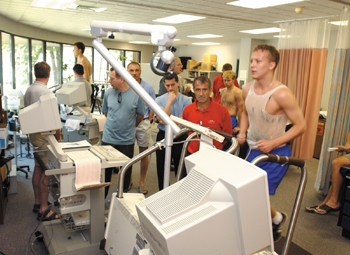
Several prospective draftees of the Stanley Cup-winning New Jersey Devils underwent physical fitness evaluations last week at VUMC’s Kim Dayani Center. The NHL team contracted with Dayani for the evaluations in advance of the 2003 NHL Draft, which was held in Nashville last weekend. (photo by Anne Rayner Pollo)
Laptops help streamline Home Care program
Vanderbilt Home Care Services is moving to a paperless environment that will allow nurses and therapists to work more efficiently and effectively.
This new way of working relies on integration of dispatch, patient care documentation, billing and quality improvement within a single computer system.
With the new system, any nurse, therapist or case manager can generate up-to-the-minute home health care quality and outcomes reports. “As far as I’m concerned, this is the beauty,” said Laura Beth Brown, director of VHCS. Generating such reports used to require manual chart review, ad hoc data entry, and creation and maintenance of separate databases.
For patients the salient feature of the new paperless system is that the VHCS nurse or therapist carries a laptop computer and uses it in the home to document patient assessments and care. As is the case in Vanderbilt Medical Group clinics, which also have gone electronic, home health patients draw assurance from knowing that their record is instantly updateable and accessible by each caregiver. (In addition to home nursing, VHCS provides patients with physical, occupational and speech therapy and social worker services.)
VHCS bought 57 laptops, 20 PCs and made other upgrades to support the new system. Remote accounts allow staff via telephone modem to upload their assignments at the start of each day and transfer patient information to a central data repository at the end of each shift.
With paper records quality analysis was piecemeal, always laborious and always to some degree retrospective. And it took about 40 pages of forms to start a patient (and you had to rewrite the demographic information on each form).
With the paperless system, not only is care documentation and analysis much easier, but remote access to the record also means that therapists, nurses, case managers and social workers have less need for daily meetings to discuss patients. “It’s as if we’re in a constant virtual team meeting,” said physical therapist Brenda Daniell. The new system also makes it easier for the agency to comply with the new national home health care quality benchmarking regime (mandated for Medicare providers) and to participate in voluntary statewide benchmarking.
The paperless system also supports use of clinical pathways, which are concise diagnosis- and procedure-based plans of care written to reflect group consensus about best practice. Use of clinical pathways and continuous assessment of pathway outcomes is a leading strategy for reducing unwanted variability of care. Working with physicians, case managers and social workers from Vanderbilt Medical Group and Vanderbilt University Hospital, VHCS teams have written and implemented home health pathways for total knee and total hip replacements; they’re working now to create pathways for wound care and outpatient stem cell transplant and later this year they’ll create pathways for congestive heart failure and stroke.













